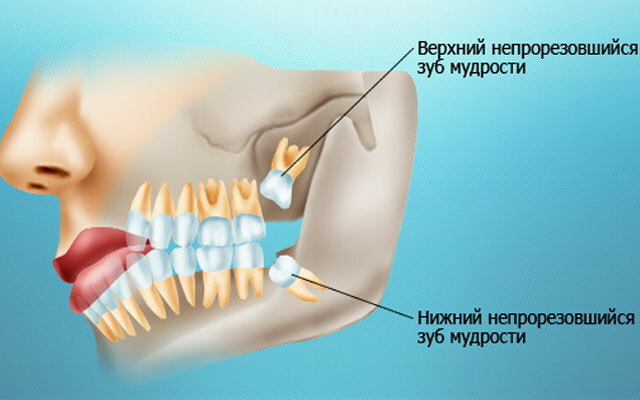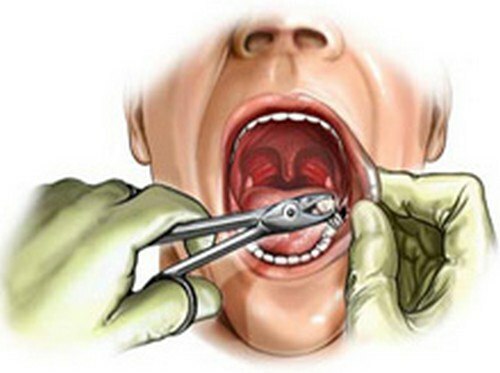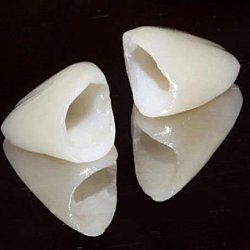What to do after a tooth extraction wisdom

At the very end of the tooth row are located third molars, or wisdom teeth - they cut through the person in the last place.It is noteworthy that the process of eruption of these teeth is very long( some people can last 2-3 years) and gives a person a lot of discomfort.According to statistics, wisdom teeth begin to climb in 18-24 years, but there are patients who start this process only by 26-28 years.If the third molars did not appear in 30 years, then they can not wait.
Contents: Features of wisdom teeth Possible problems Features of wisdom tooth extraction What to do to the patient immediately after tooth extraction wisdomFeatures of wisdom teeth
The type of teeth under consideration has several characteristics.The first is already announced in the material - the third molars later erupt.And the features are the location of wisdom teeth, anatomy and the possible development of severe complications in the process of eruption.
 Anatomical structure of the wisdom tooth: there is a wide crown and several roots - more often the wisdom tooth has 2 roots on the lower jaw, and on the top - 3 roots.This, of course, creates difficulties for the dentist when removing the third molar.
Anatomical structure of the wisdom tooth: there is a wide crown and several roots - more often the wisdom tooth has 2 roots on the lower jaw, and on the top - 3 roots.This, of course, creates difficulties for the dentist when removing the third molar.
At the end of the dentition, very little space is left, so wisdom teeth usually shift to the side, grow on the cheek, bend or not at all cut open.
Possible problems
As soon as the wisdom tooth begins to erupt, a person experiences pain, difficulties appear when opening the jaw.But often this discomfort is associated with a cold or sore throat, with caries of other teeth, which leads to the use of painkillers, illiterate treatment.
What problems can occur with the eruption of the third molar:
- Pericoronaritis is an inflammation of the surrounding tissues.In this case, a "hood" is formed over the tooth from the gum tissue, food remains and a plaque is formed under it.Naturally, it is impossible to remove the contamination, which serves as a provoking factor in the development of the inflammatory process and the appearance of fetid odor.With pericoronary, the patient will complain of intense pain when opening the mouth, raising body temperature, when examining the dentition, the dentist will note a strong puffiness in the area of the wisdom tooth location.

- Caries.The destruction of the wisdom tooth is generally considered a normal process for the dentist - the third molar grows to the side, which makes it difficult to clean it with a toothbrush.By the way, the doctor will treat the wisdom tooth only if there is free access to it, but most often it is assigned to remove it.
- Chronic cheek biting.Again, this trouble is associated only with the tilt of the wisdom tooth, it literally clings the inside of the cheek, and the sharp knobs of the tooth inevitably lead to trauma.A dentist can recommend grinding the edges of a tooth crown or smoothing the edges.
- Displacement of teeth in a row.Usually the wisdom tooth does not have enough space; when cutting, it exerts strong pressure on the remaining teeth and shifts them.Many patients, with the eruption of the third molar, complain of severe pain in the fangs - they suffer the most when teeth are displaced, as they are slightly "advanced" in relation to other "neighbors".
- Cyst.If the inflammatory process around the wisdom tooth progresses, it is likely that a cyst( benign neoplasm) is formed.If this happens, the dentist will appoint the removal of the third molar - this is the only correct decision.
- Numbness of the jaw.This can happen if, during the eruption of the wisdom tooth, the branches of the trigeminal nerve are squeezed.
Features of wisdom tooth removal
If the wisdom tooth has erupted completely, is located in a row exactly, is available for cleaning and treatment, then dentists recommend that it not be removed.But this happens very rarely, so in most cases, wisdom teeth are removed before they completely break through.
Naturally, a similar procedure is performed under local anesthesia - the dentist makes an injection with an anesthetic directly into the surrounding third molar tissue.It should immediately be taken into account that if there is purulent content in the tissues, then the anesthetic will not fully manifest its effect, although it will reduce the intensity of the pain syndrome.

To remove the third molar, doctors use special forceps, in many cases( due to improper position of the wisdom tooth) have to work "elevators" - a special tool that allows you to remove the remains of roots and teeth from the wound.
Immediately after removal( within the first 24 hours), a puffiness is formed on the spot of the wisdom tooth, the patient will experience a non-intensive pain, which, if food gets into the wound, increases.After 2-3 days, all unpleasant sensations and pain disappear without a trace.
Note: if the pain becomes more intense, the swelling does not subside, the body temperature rises and an unpleasant odor appears from the mouth, then you should immediately seek medical help.A dentist will examine the wound, wash it and prescribe antibiotics to stop the inflammatory process.
What to do to the patient immediately after the removal of the wisdom tooth
There are a number of specific recommendations from dentists that need to be observed - this will help to recover quickly after the removal of the wisdom tooth. These include:
- Remove tampon from the wound 10 minutes after removal.The doctor always leaves a gauze swab for a quick stop of bleeding, but that does not mean you can walk with him for an hour.Such a prolonged presence of a tampon in the oral cavity can lead to infection of the wound - viruses and bacteria penetrate into the wound through wet tissue.In addition, there is a danger that the blood clot will be formed too long or will leave with a tampon - bleeding is guaranteed.
- Do not eat food and liquid for 2-3 hours after removal.The wound in this period is still open, the blood clot can not form completely, so the risk of infection and bleeding remains high.
- Do not exercise on the day of the procedure.You can not go to a sauna or a sauna, take a hot bath, exercise.All these actions can lead to increased blood pressure and bleeding from the wound of the remote wisdom tooth.
- Do not rub your cheek.If there is pain, it is advisable to apply a cold water bottle, ice.When the tissues are heated, the swelling will only increase, infection of the wound can occur, and bleeding will increase.
- Do not rinse the oral cavity.This procedure can wash the blood clot out of the wound, which will serve as the beginning of bleeding from it.Dentists recommend to hold a bath with a solution of baking soda or a decoction of chamomile medicinal - the prepared liquid should be put into the mouth, "pour" on the right side and hold it for 2-3 minutes, then spit it out.

- Do not brush your teeth.On the day of removal of the third molar, doctors admit to missing the procedure for cleaning teeth, but warn that it is not necessary to eat grainy foods, sweets, too hard food that day.
- Do not examine the wound.Often patients will examine the socket after removing the wisdom tooth with a tongue or even a toothpick - this is strictly forbidden!Even if there is a feeling that a foreign body has entered the wound, it is better to consult a dentist.Often the discomfort is caused by a medicine that the doctor lays in the wound, but you can not get it out.
If the dentist after the removal of the wisdom tooth has prescribed antibacterial drugs, then you need to do this in a strictly indicated dosage and the recommended course.If the fever has occurred 2 or more times, then do not take antipyretic drugs - it is advisable to seek help from the dentist, because there is a high risk of developing a serious inflammatory process, not only in the tissues of the gum but also in the jaw.
A wisdom tooth can deliver a lot of troubles and problems, so it's better to remove it immediately.If you adhere to the recommendations of a doctor, then the work of the dentist will pass almost unnoticed for the patient - with a successful outcome, any discomfort and pain disappear on the second day after visiting the clinic.
Yana Tsygankova, medical reviewer, therapeutist of the highest qualification category.



